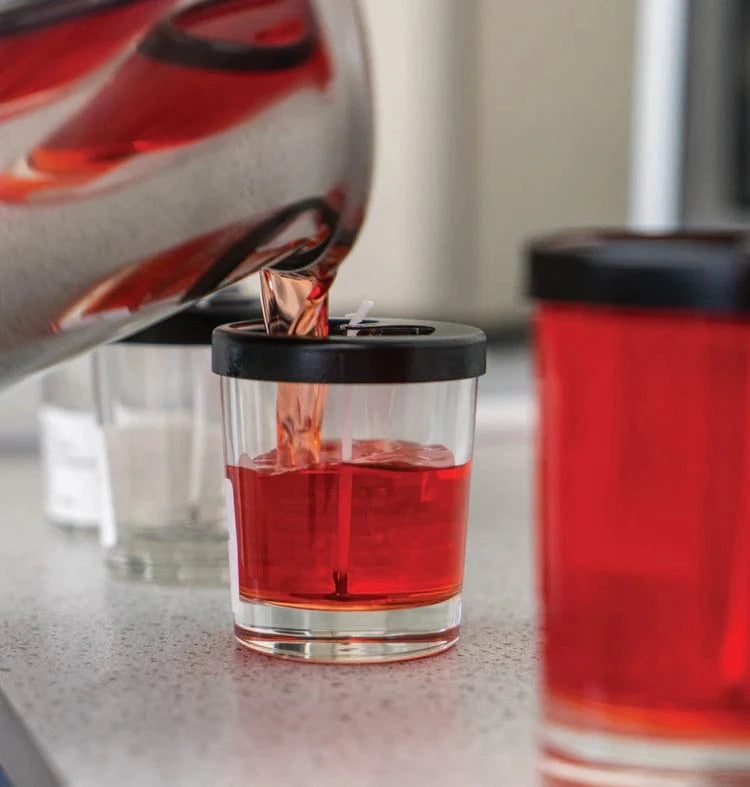Your questions, answered.
What is a small melt pool?
A melt pool is the circular pool of melted wax that forms around the wick on the surface of the candle as it burns. If the melt pool doesn’t reach the edge of the container and doesn’t get any larger regardless of how long the candle burns, the candle would be considered to have a small melt pool. In extreme cases, a small melt pool is referred to as “tunnelling”.
Why do small melt pools happen?
Wrong choice of wick
The choice of the wick is crucial to obtaining a full melt pool and is often the reason for poor candle performance. A well-chosen wick will generate a flame that is big enough to maintain a good melt pool and will consume a suitable amount of wax (fuel) per hour. A poorly chosen wick will result in insufficient or excessive rates of consumption.
For example, in a 20cl plant-based candle, you’d expect the wick to consume a little over 4 grams per hour. In a 20cl CS1 (paraffin) candle, a smaller wick would suffice, as around 2.75 grams per hour will create a good melt pool. If you stray too far from this, you won’t get a good melt pool. A 30cl RCX or 464 candle will typically consume around 5 grams per hour.
Type of wax
The choice of wax can also lead to smaller melt pools. For example, it can be more difficult to create melt pools in some waxes than others. The reason for this is that other than directly below the flame, the melt pool is formed through ‘conduction’ and to a lesser degree ‘convection currents’ within the melt pool.
Different waxes may have different Thermal Conductivity. Paraffin, for example, has better thermal conductivity than plant-based waxes and it also has lower viscosity, resulting in better convection currents in the melt pool. This means smaller wicks and rates of consumption can generate an equivalent flame and melt pool. Even within plant waxes, there is huge variation here. So, choosing a high-quality wax, produced by a reputable company, is important.
How to avoid small melt pools
Use Candle Shack recipes as a starting point
The easiest way to avoid a small melt pool is to follow one of Candle Shack’s recipes as they have been specifically designed and tested to generate full melt pools. Make sure you follow the usage recommendations closely and that you weigh the ingredients accurately for the most consistent results.
Once happy with the recipe, you can always increase the wick size to improve the hot throw, making sure that you don’t go too far and create excessive soot. Each recipe PDF contains test reports showing the Soot Index, so you can figure out how much flexibility you have on wick sizes. For example, if a recipe has an average soot index of 0.1, then you can probably increase the wick by 1 or 2 sizes, as the maximum average soot index is 1.0. If the soot index was already 0.7, then you should probably stick with the wick suggested in the recipe.
Optimise your wicks
Another option, if you choose not to start with a recipe, is to experiment with your wick and fragranced wax combination until you achieve a sensible ‘rate of consumption’, as this typically generates a full melt pool. We’d recommend starting with the wick families suggested on the product page of each wax and testing various sizes.
Within each wick family, a higher number indicates a higher thread count and thus a more powerful wick, so if a particular type of wick gives a small melt pool, try increasing the size of the wick within the same family. For example, if a CL12 wick gives a small melt pool, try a CL14 or CL16 wick instead.
Typical target rates of consumption for RCX or 464 are as follows:
- 30cl = 5g/hr
- 20cl = 4.25g/hr
- 9cl = 3.5g/hr
Get smart with your oils
Not all oils are made the same. Experienced candle makers know that to obtain optimal performance, the wax and oil you use must be compatible and ideally optimised to work together. When we create candles for luxury brands, the perfumer designs the fragrance to work in the specific wax that the candle will use. At Candle Shack, every one of our oils has been developed to work in plant-based waxes and thoroughly tested in our R&D laboratory. Most will work in paraffin or hybrid waxes too, but they are developed to work in RCX/464.
Most online sellers do not have a lab or any experience in making candles, so unless you are only making wax melts, be cautious when buying from generalist stores, as the oils will be hit and miss, and you can spend weeks/months trying to get incompatible materials to work together. Reducing the amount of fragrance in your candle can also help with melt pool formation. This is especially true for oriental or woody fragrances, which can be highly viscous.
Use RCX wax
RCX wax is easier to wick than soy waxes, as it forms full melt pools more readily and with smaller wicks. It also has a lot of anti-oxidants, resulting in less discolouration of the melt pool as the candle burns down. We also have more recipes for RCX than any other wax, meaning you can save time and money and get market-ready products made more quickly.


